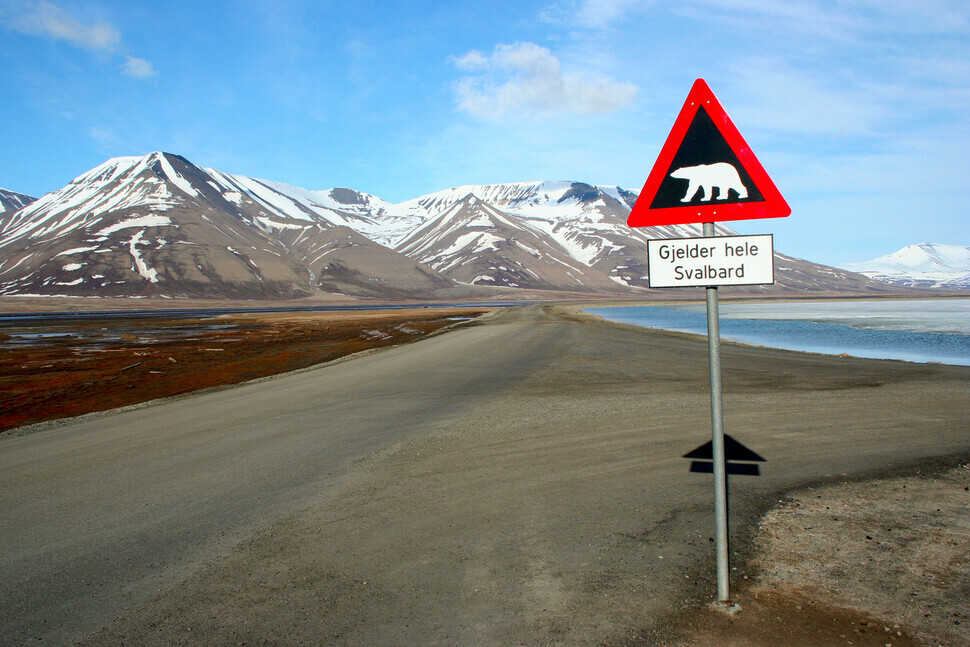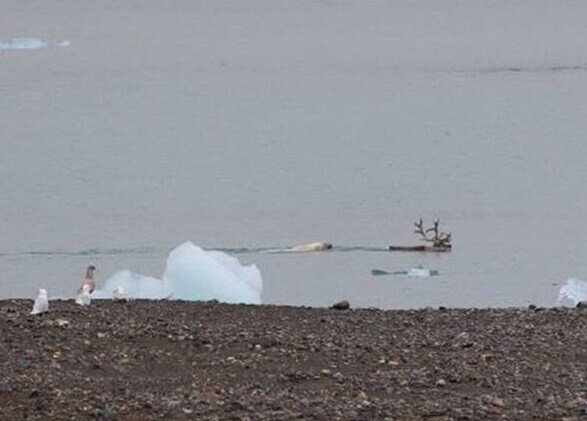hankyoreh
Links to other country sites 다른 나라 사이트 링크
With sea ice melting, polar bears now prey on reindeer, not seals

Scientists have published the first official report, complete with videos and photographs, of a polar bear hunting a full-grown reindeer.
Polar bears are regarded as marine predators. Their primary prey is seals, though they are also known to eat other sea animals, including whales and walruses. But as sea ice melts due to climate change, polar bears, like other land predators, have been setting their sights on hoofed animals — in this case, reindeer.
Lech Stempniewicz, an ecologist at the University of Gdansk, and other researchers reported that polar bears are finally hunting reindeer on Norway’s Svalbard archipelago in an article published in the latest issue of the scientific journal “Polar Biology.”
“This increase in hunting is probably linked to the reduced ice cover, with bears spending more time on land, and a growing reindeer population,” the researchers said.

The 300 polar bears living on Svalbard get most of the energy they need to survive the winter by eating ringed seals (Pusa hispida) and bearded seals (Erignathus barbatus) in spring and summer.
Polar bears are adept at hunting seals and even “have a unique ability to digest seal blubber,” the researchers noted. But with sea ice freezing later and melting earlier than before, the time available for seal hunts has been sharply reduced.
Scientists have long wondered why hungry polar bears have resorted to munching on seaweed and ransacking garbage cans instead of catching calorie-rich reindeer. During the summer, Svalbard reindeer reach a weight of 118 kilograms (260 pounds), and they share their habitat with polar bears.
It was previously thought that polar bears weren’t fast enough to catch reindeer or that they simply didn’t view reindeer as sources of food. But in this paper, researchers observed that “the high frequency of reindeer remains found in polar bear scats from Svalbard, reaching 27.3% in summer, suggests that reindeer may be a significant part of the polar bear’s diet in that area.”

Researchers finally witnessed a polar bear catching a reindeer in the vicinity of the Polish Polar Station at 6 pm, Aug. 21, 2020. A young female polar bear, with her nose in the air, sniffing for prey, made a stealthy approach toward a herd of reindeer that were nibbling on ivy between some rocks by the water.
A full-grown male reindeer who didn’t spot the charging polar bear until it was too late jumped into the ocean. In the water, the polar bear quickly closed the gap and closed its jaws around the reindeer’s neck. After drowning the reindeer, the polar bear dragged it out of the water.
“The most interesting aspect of this particular observation is that the bear drove the reindeer male into the water,” the researchers wrote.
“In general, reindeer run faster and have greater stamina than polar bears over longer distances. [. . .] A bear is a short-distance runner and can overheat if it has to run fast for a longer time.”
By driving the reindeer into the ocean, the researchers suggested, the polar bear may have been trying to keep its body from overheating.
By Cho Hong-sup, environment correspondent
Please direct questions or comments to [english@hani.co.kr]

Editorial・opinion
![[Column] Life on our Trisolaris [Column] Life on our Trisolaris](https://flexible.img.hani.co.kr/flexible/normal/500/300/imgdb/original/2024/0505/4817148682278544.jpg) [Column] Life on our Trisolaris
[Column] Life on our Trisolaris![[Editorial] Penalties for airing allegations against Korea’s first lady endanger free press [Editorial] Penalties for airing allegations against Korea’s first lady endanger free press](https://flexible.img.hani.co.kr/flexible/normal/500/300/imgdb/original/2024/0502/1817146398095106.jpg) [Editorial] Penalties for airing allegations against Korea’s first lady endanger free press
[Editorial] Penalties for airing allegations against Korea’s first lady endanger free press- [Editorial] Yoon must halt procurement of SM-3 interceptor missiles
- [Guest essay] Maybe Korea’s rapid population decline is an opportunity, not a crisis
- [Column] Can Yoon steer diplomacy with Russia, China back on track?
- [Column] Season 2 of special prosecutor probe may be coming to Korea soon
- [Column] Park Geun-hye déjà vu in Yoon Suk-yeol
- [Editorial] New weight of N. Korea’s nuclear threats makes dialogue all the more urgent
- [Guest essay] The real reason Korea’s new right wants to dub Rhee a founding father
- [Column] ‘Choson’: Is it time we start referring to N. Korea in its own terms?
Most viewed articles
- 1New sex-ed guidelines forbid teaching about homosexuality
- 2OECD upgrades Korea’s growth forecast from 2.2% to 2.6%
- 3[Column] Life on our Trisolaris
- 460% of young Koreans see no need to have kids after marriage
- 5[Guest essay] Maybe Korea’s rapid population decline is an opportunity, not a crisis
- 6Inside the law for a special counsel probe over a Korean Marine’s death
- 7Korean government’s compromise plan for medical reform swiftly rejected by doctors
- 8Months and months of overdue wages are pushing migrant workers in Korea into debt
- 9Two lung cancer deaths at Samsung Electronics deemed occupational in nature
- 10Trump asks why US would defend Korea, hints at hiking Seoul’s defense cost burden